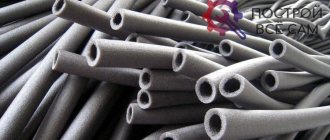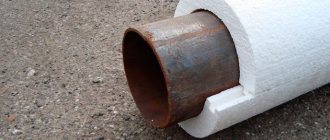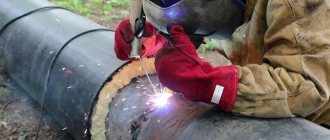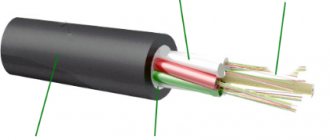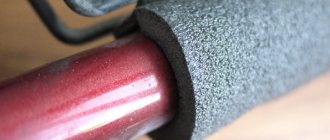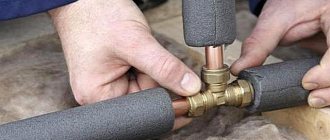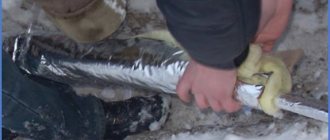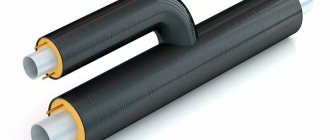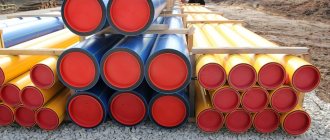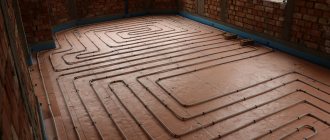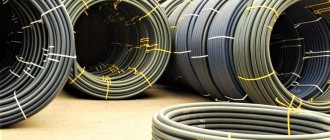Why is high-quality hydro- and thermal insulation of main pipes important? Regardless of the type of installation (closed or open), due to the long length of the pipelines, heat loss occurs; the metal is negatively affected by temperature changes and moisture, which can lead to damage. Insulation of steel pipes protects the system from mechanical and atmospheric factors, increases its service life, and maintains optimal conditions inside the system.
A protective layer is applied to pipes during the construction of pipelines (in the factory) or during operation (as part of repairs). The technology and materials used for insulation must meet strict technical standards. It is imperative to comply with all the requirements specified in the documents and instructions, because the uninterrupted operation of housing and communal services systems, industrial and energy facilities depends on the quality of work and the quality of insulators.
The choice of materials and the actual installation of insulation is made based on the type of pipelines, their installation location, and operating conditions. What matters is humidity, type of transported substance (oil, gas, water), temperature, and mechanical loads. The following requirements have been adopted for the calculation of insulation systems and their installation:
- protective coatings should not negatively affect the environment;
- it is necessary to take into account the thermal characteristics of the system;
- insulation must ensure pipe protection from corrosion, fire safety and durability of communications.
Important performance characteristics of insulators include density, vibration resistance, elasticity, compressibility, thermal conductivity, and corrosion resistance. When choosing a material, their thickness, flammability and other properties are taken into account.
The service life of the pipeline is affected by its location, weather conditions, and the intensity of mechanical loads. Pipes with insulation are protected from corrosion and other factors, so they last much longer without the need for repairs.
Advantages of insulated pipes
Insulation of steel pipes contributes to:
- thermal stability of the transported medium for process safety;
- increasing energy efficiency, reducing heat loss and reducing CO2 emissions due to reliable thermal insulation;
- system safety, personnel protection from hot surfaces;
- corrosion prevention due to low humidity and condensation;
- reducing noise caused by turbulence in high-speed environments;
- fire protection of the installation.
All these advantages are achieved only with the correct choice of insulators and compliance with the technology of their installation.
Where is galvanized protective casing used?
Galvanized insulation is used for gas pipes.
Galvanized casing is used to protect and insulate chimneys and gas exhaust pipes in private homes. Also used for pipelines in the oil industry.
A zinc casing is an indispensable item for covering the surface of heating mains. It not only protects the metal from destruction, but also reduces heat loss.
Advantages of galvanized insulation:
- attractive appearance;
- easy installation;
- durability.
In the chemical industry, zinc casing is used to protect workers from accidental contact with hot surfaces, work with which can cause injury to a person.
Polyurethane foam insulation
Polyurethane foam is applied to the surface of pipes by spraying. Voratek and Izolan polyurethane foam insulators are used to protect standard steel and galvanized pipelines: the materials are environmentally friendly due to their environmentally friendly composition. If the application technology is followed, they increase the service life of metal structures to 30 years or more. Protection is often enhanced by galvanized polyethylene coating.
The disadvantages of pipes with polyurethane foam include flammability, destruction under the influence of ultraviolet radiation, the need to completely replace damaged ones when moisture is detected - repairs are impractical. Inside the polyurethane foam layer, a SODC is installed - an operational remote monitoring system that uninterruptedly monitors problems in the functioning of the insulation. It is used to control the humidity level and other indicators of the system.
Pipes with polyurethane foam insulation are manufactured according to GOST 30732-2006. The standard lists the requirements for products and indicates the permissible technical indicators of the insulating layer:
- maximum thermal conductivity at 50 degrees Celsius – 0.033 W/m°C;
- minimum strength during deformation/compression – 0.3 MPa;
- minimum density – 60 kg/m³.
Insulated polyurethane foam pipes can withstand significant loads (temperatures up to 140 degrees, pressure up to 1.5 MPa), therefore they are often used for laying underground/ground heating mains.
Types of insulating coatings
Coating materials differ from each other in technical characteristics, on which the service life of the product depends.
- Types of insulating coatings
- Use of galvanized pipes
- Advantages of galvanized insulation
- Galvanizing technology Initial stage
- Determining the dimensions of the coating
- Manufacturing of metal blanks
- Installation of galvanized coating
The top layer is used:
- Cink Steel;
- aluminum;
- stainless steel;
- fiberglass;
- synthetic films;
- glass cement;
- fiberglass-based materials.
The most reliable option in operation is a coating made of sheets of metal and its alloys, and the best protection is provided by galvanized steel.
Polymer mineral foam insulation
PPM is used to protect pipes made of black or galvanized steel. The foam-polymer-mineral coating is applied in three layers:
- Moisture-proof 5-10 mm thick. Function: protects metal from corrosion.
- Thermal insulation. The thickness depends on the ambient temperature (climatic conditions of the region). Function: maintaining the optimal temperature of the working fluid. Thermal insulation materials have a porous structure.
- External thickness 10-15 mm. Function: waterproofing and mechanical protection of pipes. The outer layer determines the ultimate strength of the pipeline.
Pipes with three-layer PPM insulation are used for above-ground and underground installation of pipelines with an operating temperature of up to 150 degrees and a maximum pressure of 2.5 MPa.
Thermal insulation Termoflex
A recognized leader in the production of thermal insulation materials, Termoflex is successfully developing and has already won the trust of many consumers. Thermal insulation of Termoflex with foamed polyethylene for pipes has the following advantages:
- low flammability;
- elasticity and strength;
- resistance to water vapor diffusion;
- anti-corrosion resistance;
- uniform structure of the material.
All these thermal insulation qualities are fully preserved throughout the entire period of operation. Thermoflex thermal insulation is available in two types: sheet and pipe. Sheet thermal insulation is applicable for large-diameter pipes and flat surfaces, while pipe insulation provides complete thermal protection for pipelines. Thermoflex thermal insulation is successfully used not only in heating systems, but also in water supply, air conditioning, ventilation and refrigeration systems. Correctly and timely installed thermal insulation allows you to extend the life of main pipelines.
Insulation of pipes is a necessary measure for the full operation of the equipment. On the site you can purchase modern and high-quality products.
Insulation using extruded polyethylene
Pipes with extruded polyethylene insulation are produced in the factory. Strengthening of structures is carried out after high-quality preparation; the protection consists of three layers:
- Epoxy resin. The layer fills chips, cracks and other defects on the metal surface and evens it out.
- Adhesive layer. Designed for gluing extruded polyethylene to a pipe.
- Insulating layer made of polyethylene.
Pipes reinforced in this way can last more than 50 years without the need for repairs. Other advantages of polyethylene protection include environmental friendliness (no harm to the environment, including the soil when laying pipes underground), resistance to corrosion, water hammer, temperature changes, chemical and other aggressive environments.
Thanks to the combination of the listed characteristics, insulated pipes are used in the construction of almost all types of pipelines: gas, water, underwater, oil. Permissible temperature of the working environment: from -20 to +60 degrees.
Galvanizing technology
In order to obtain a high-quality product, each of the successive types of work must be performed at a high level. Defects and defects at one stage will inevitably lead to defects of the product as a whole.
First stage
First of all, insulation is laid on the pipe materials. The insulating layer should tightly envelop the surface of the pipe blank, leaving no empty spaces.
On vertical sections of the highway this layer should not slide.
To do this, the insulation is fastened using a wire frame. Strings are installed on it, which prevent the fastening rings and bandages from slipping.
Determining the dimensions of the coating
When installing the coating, an overlap is performed, the parameters of which are prescribed in the technical documentation.
The dimensions of galvanized protection are determined based on the dimensions of the insulation, taking into account the overlap. Production equipment must ensure that the workpieces accurately comply with the provided drawings.
Manufactured metal coating elements with galvanized protection must comply with GOST 30732-2006.
Important! When producing pipe products with galvanized insulation, small areas on both sides of the workpieces are left unprotected. These sections are necessary for fastening to each other when connecting pipes. After fastening is completed, the joints are insulated. This circumstance must be taken into account when taking measurements.
Manufacturing of metal blanks
Based on measurements, metal coatings are made: cylinders and shells (for straight sections of the highway).
In addition to straight elements, bends, transition cones, and plugs are manufactured.
The production process consists of sequential operations:
- unwinding of galvanized steel rolls;
- cutting;
- rolling;
- zigovka;
- drawing holes.
Requirements, Properties and technical characteristics of the coating
When laying pipelines openly, to protect the thermal insulation of the pipes, they are made using a spirally rolled shell made of thin-sheet galvanized steel of class 1 or 2 (GOST 14918-80), in accordance with the requirements of SNiP 2.0414-88.
The surface of the shell, according to GOST, should be perfectly smooth on the outside or with slight longitudinal stripes and waviness that does not take the pipe wall thickness beyond the permissible limits, and rough on the inside. Both surfaces should be free of bubbles, cracks and foreign matter.
Main technical characteristics of the products:
- wall thickness - 0.55 - 1.0 mm;
- range of outer diameters - from 100 to 1600 mm;
- the length of straight sections is 8 -12 m for pipes with a diameter of less than 219 mm and 10 - 12 m for products with a diameter of 273 mm or more.
Requirements according to GOST 9.602 2005
The regulatory document describes the conditions for the formation of highly reinforced insulation, requirements for materials, and characteristics of the insulating layer. The technology is used for all types of pipelines laid in the ground. For gas mains there is a maximum pressure limit - it should not exceed 1.2 MPa. Very reinforced insulation is used for the protection of underground tanks and steel communication structures.
The table indicates the operational and technical requirements for coatings of this type.
| Index | Meaning |
| Adhesion to steel, N/cm, at temperatures up to +20 °C to +40 °C | – 35-70 10-35 |
| Adhesion in overlap, N/cm tape to tape wrap to tape | – 5-35 5 |
| Impact strength, J | 4,25-10 |
| Tensile strength, MPa | 10-12 |
| Water saturation in 24 hours, % | No more than 0.1% |
These parameters are controlled during the manufacturing process of products and their operation. The thickness is checked using thickness gauges or similar instruments without damaging the outer shell. During repairs, the integrity of the protective layer is restored. It is important that its characteristics match those of the rest of the coating.
Advice - after manual installation of insulation, 10% of the surface is checked. This is done at 4 points around the circle.
Designs and types of shaped products
Utility networks have a complex spatial configuration and include shut-off, control and control valves. Therefore, to insulate such structures, not only straight sections are needed, but also various shaped elements: tees, bends, transitions, plugs, etc.
Straight section
This is a ready-to-install product in the shape of an open cylinder. It is mounted overlapping with other segments, secured with locks - latches, self-tapping screws or rivets.
Main standard sizes of straight sections of shells:
- length – from 470 mm to 1000 mm;
- outer diameter – from 60 mm to 500 mm (in 10 mm increments), from 90 mm to 1000 mm (in 10 mm increments);
- holes for fastening – 4-6 pcs. with a diameter of 2.7 mm for screws or in quantities of 3-6 pcs. with a diameter of 3.2 mm for installing rivets or snaps.
Retraction
Bends - parts made of galvanized steel with a thickness of 0.55; 0.7; 1.0 mm with a bend radius of 90 or 45 degrees. They are used in places where the pipeline changes direction to protect the thermal insulation of shaped elements.
Tee
Tees protect branching points of pipeline networks. Available in several versions:
- round T-shaped 90 degrees;
- straight with the same length of pipes;
- with shortened shoulder length at 30 and 45 degrees.
They are installed in the same way as rectilinear products with an overlap, fastened with metal screws (such as bugs) or rivets.
Plug/transition
End caps - designed to protect the heat-insulating layer at the end of pipelines. They consist of two parts with ridges, mounting holes and screws.
A transition is a straight section of a shell of concentric or eccentric shape, ready for installation. It has one longitudinal and two transverse ridges, holes for fasteners and the required number of screws. It protects a shaped product installed at the junction of pipes of different diameters or made of different materials.
Zeppelins
Zeppelins are round shaped products made up of segments (petals).
Along the edge of each segment there are ridges and holes for rivets (screws). Zeppelins are used to insulate the ends of tanks and reservoirs.
Casings for valves and flanges
They are made in the form of a split box with the necessary ridges and special locks - latches, for rigid and reliable fixation of parts of the product. They serve to protect the heat-insulating layer from the negative effects of the environment in places where shut-off devices, various instrumentation and flange connections of the pipeline system are located.
Cones
Cone shells are a type of galvanized coating of a cone shape with the presence of longitudinal and transverse ridges. They perform the function of protecting the thermal insulation layer on the end surfaces of containers, on chimney pipes and ventilation outlets from the street side.
Insets
The shell for insertion is a straight section that has longitudinal and transverse ridges and a curved connection for mating with the main insulation element, holes for fasteners and the required number of screws. It is used to protect the insulation layer at the junction (branch) of lines from the main pipeline.
approximate cost
The approximate cost of straight sections of galvanized steel casings is given in the table.
| Outside diameter | Price per piece, in rubles |
| Ø 100 | 180 |
| Ø 125 | 230 |
| Ø 160 | 300 |
| Ø 200 | 370 |
| Ø 250 | 460 |
| Ø 315 | 565 |
| Ø 400 | 880 |
| Ø 450 | 992 |
| Ø 500 | 1110 |
| Ø 560 | 1225 |
| Ø 630 | 1378 |
| Ø 710 | 1686 |
| Ø 800 | 2058 |
| Ø 1000 | 2572 |
| Ø 1250 | 3200 |
Features of CPI coating
The pipes are coated inside with a cement-sand mixture, which has a low water-cement ratio. A centrifugal application method is used to achieve an even layer of the required thickness. The seal forms a layer ranging from 4 to 16 millimeters, which protects the pipes from mechanical damage.
Under the protective layer, the metal pipes are passivated; the material is exposed to a solution formed due to the hydration of the cement substance, called calcium hydroxide.
A film is formed on the metal of the pipe that does not allow water to pass through; it is protected by cement-sand insulation. When the protective layer comes into contact with water, it releases calcium carbonate, which helps repair small cracks in the coating.
CPI protects pipes from corrosive changes. Since there is no rust on the surface, the pipes inside are smooth. In addition, CPI promotes the release of a hydrophilic layer in the form of a gel, which is formed with the help of clay particles with trace elements of iron and calcium. This property reduces friction of the liquid against the walls, improving the level of permeability; the layer also protects the pipes from fouling.
Internal insulation increases service life, even if corrosion appears on the external surface, while the quality and properties of the pipeline do not change.
Types of factory-made epoxy insulation
There are several types of coatings using epoxy powder:
1.single-layer insulation type.
2.type of double-layer insulation.
3.type of three-layer insulation, in this case an epoxy-polyolefin coating is used.
Attention! The use of one type of coating is determined by the purpose of the future pipeline, its operating conditions, the properties of the transported liquid, the size of the pipes, and also take into account economic factors.
How to apply epoxy insulation to the inside of a pipe.
Before pipes are covered with insulation, the products undergo preparation.
1.in a special furnace, the rolled pipes are heated to sixty degrees.
2. The pipes are dried and prepared for chrome treatment.
3.pipes are sandblasted.
4.apply layers of epoxy insulation using special equipment.
The thickness of the protective layer must be more than 150 microns.
The maximum temperature during operation should be one hundred and fifty degrees, and the permissible diameter of pipe rolls is 57 - 1420 millimeters.
5.testing of products for compliance with the required indicators; pipes are tested for resistance to negative factors. After passing all levels of verification, the products are put on sale.
Varieties and applications
The most popular of all types of steel products are galvanized pipes, which differ in purpose:
- to create a water pipeline;
- carrying out household and economic communications;
- gas pipelines;
- heating system installations.
Pipeline made of galvanized steel
Depending on the application, they are made of different diameters, according to established standards:
- To carry water and gas, pipes manufactured in accordance with GOST 3262 are used;
- Electric welded products meet the standards of GOST 10704;
- Seamless and profile.
To install water supply in an apartment, as well as create a heating system, pipes made in accordance with GOST 3265 are used. They have a number of advantages:
- Anti-corrosion resistance. This is especially important in the application of steel products. Thanks to the galvanized coating, the water supply does not rust and lasts much longer;
- The service life of galvanized metal systems exceeds 25 years;
- Compared to conventional metal system elements, they are much lighter. This simplifies the operation and transportation of these products;
- Convenient when creating the desired design. They can be cut to desired sizes, welded and connected in a specific configuration.
Metal products of different diameters
*
Externally, all steel products look the same, they differ in the thickness of the walls. To create plumbing and heating in a residential area, elements of medium precision class are used. If outdoor use is intended, then insulation of all galvanized steel pipes will be required, otherwise the liquid in the pipeline may simply freeze and create a lot of problems with the life support of the house.
First you need to understand the types and features of insulation.
